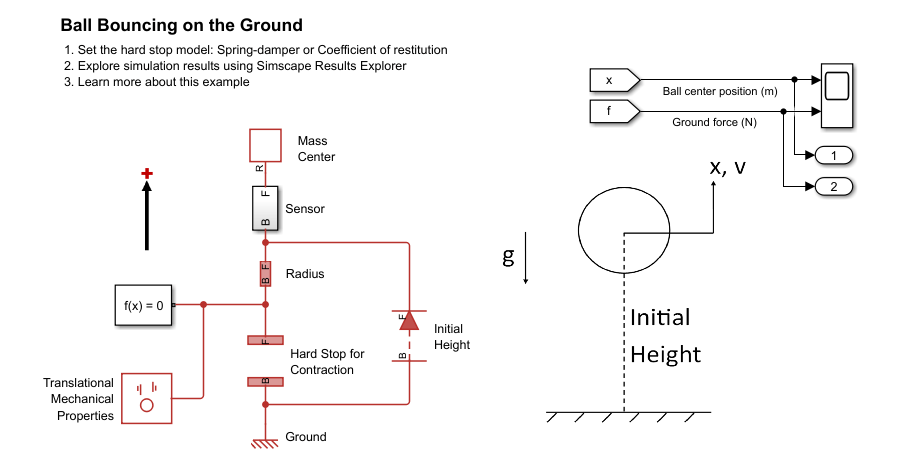Translational Hard Stop (PB)
Libraries:
Simscape /
Foundation Library /
Translational /
Elements
Description
The Translational Hard Stop (PB) block represents a mechanical translational hard stop that restricts the relative position of two bodies to be greater than or equal to 0 m. You can model contact between the two bodies either as a continuous spring and damper or as an instantaneous impulse based on a coefficient of restitution.
Connections B and F are position-based mechanical translational conserving ports. When the hard stop is disengaged, port F has a more positive position than port B. Force acts from port B on port F. Positive force acts to disengage the hard stop. Length is the gap between the two sides of the hard stop:
where xB and xF are absolute positions of ports B and F, respectively.
Models Based on Stiffness and Damping
In hard stop models based on stiffness and damping, the impact interaction between the two sides is assumed to be elastic. The block models this elasticity with the Contact stiffness parameter. To account for energy dissipation and nonelastic effects, the block uses the Contact damping parameter.
The basic hard stop model, Full stiffness and damping applied at bounds,
damped rebound, uses these equations:
where:
f is the interaction force between the two sides.
K is the contact stiffness.
D is the damping coefficient.
v is the relative velocity.
vF and vB are the absolute velocities of ports B and F, respectively.
In the Full stiffness and damping applied at bounds, undamped
rebound hard stop model, the equations contain an additional term,
ge(v,0). This term ensures that the block does not
apply damping on the rebound.
The relational function ge (greater than or equal) does not
generate zero crossings when the velocity changes sign. For more information, see Enabling and Disabling Zero-Crossing Conditions in Simscape Language.
However, the solver treats the ge function as nonlinear. Therefore, if
simscape.findNonlinearBlocks indicates that the rest of your network is
linear or switched linear, use the Full stiffness and damping applied at
bounds, damped rebound model to improve performance.
The default hard stop model, Stiffness and damping applied smoothly through
transition region, damped rebound, adds a transition region to the equation.
In the transition region, the block smoothly ramps up the force from zero to the full value.
At the end of the transition region, the block applies the full stiffness and damping. On
the rebound, the block smoothly decreases both stiffness and damping forces to zero. These
equations also use the ge relational function, which does not produce
zero crossings.
Model Based on Coefficient of Restitution
Unlike the models based on stiffness and damping, this model does not allow penetration of the two sides of the hard stop. The hard stop behavior is represented by a mode chart with two regular modes and two instantaneous modes:
FREE— There is no force transmission between the two sides of the hard stop. In this mode, f = 0, length >= 0.CONTACT— The gap is closed. In this mode, v = 0, length < 0.RELEASE— The instantaneous mode needed to transition fromCONTACTtoFREE.IMPACT— The instantaneous mode used when the two sides of the hard stop bounce.
When the two sides of the hard stop hit each other slowly, with a relative speed less than the static contact speed threshold, the two sides stay in contact. Otherwise, the sides bounce. When the sides bounce, they lose speed due to the coefficient of restitution. In contact mode, the relative speed is 0. To transition from the contact mode to free mode, a tensile force greater than the static contact release force threshold must be applied to the hard stop, and the transition must go through an instantaneous release mode to set the initial speed.
This modeling option improves simulation performance because static contact mode does not require the block to keep computing hard stop force when the block is in contact mode.
Variables
To set the priority and initial target values for the block variables prior to simulation, use the Initial Targets section in the block dialog box or Property Inspector. For more information, see Set Priority and Initial Target for Block Variables.
Nominal values provide a way to specify the expected magnitude of a variable in a model. Using system scaling based on nominal values increases the simulation robustness. Nominal values can come from different sources, one of which is the Nominal Values section in the block dialog box or Property Inspector. For more information, see Modify Nominal Values for a Block Variable.
Examples
Ports
Conserving
Parameters
Extended Capabilities
Version History
Introduced in R2024b

